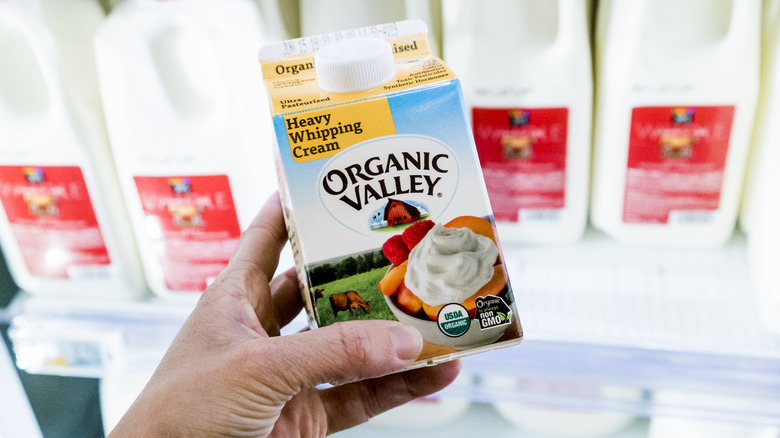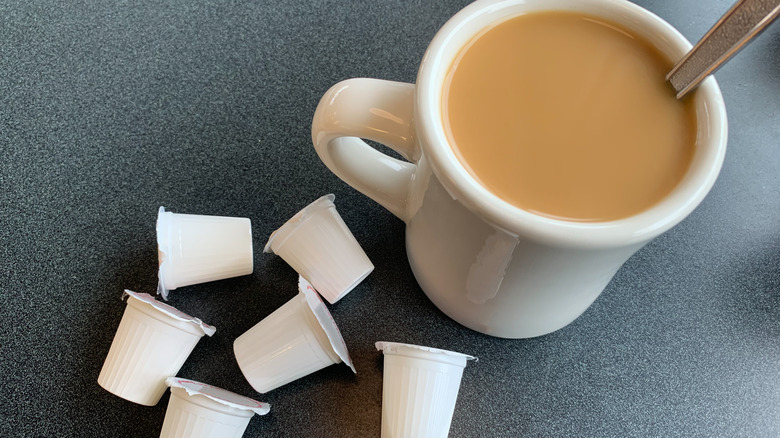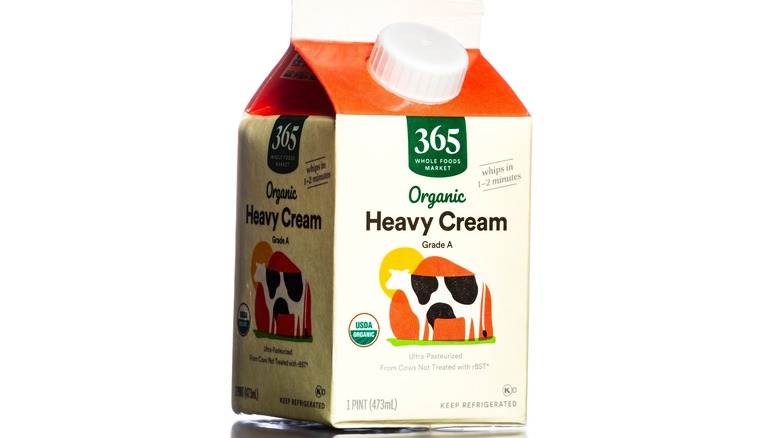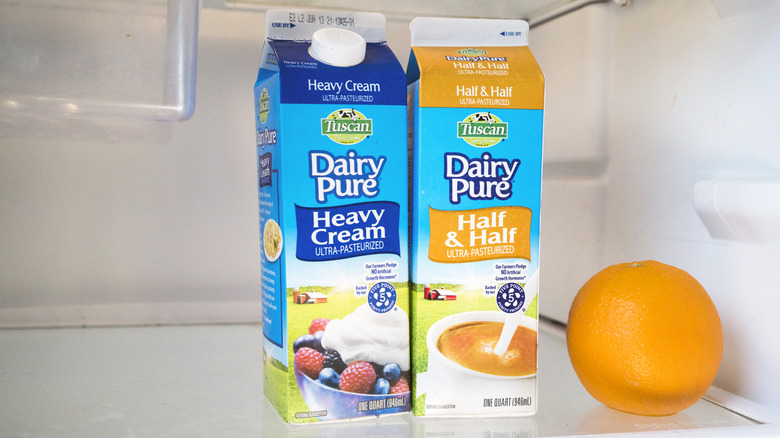The Difference Between Half-And-Half And Heavy Cream
The variety of milk-based products available is honestly incredible. There are so many delicious ways to drink and eat dairy. But, with lots of variety comes a little confusion. What exactly are we buying? Half-and-half and heavy cream are two cooking staples that seem similar but aren't, so what's the difference? When it comes to differentiating milk products, it largely comes down to milk fat content. Whole milk has 3.25 % milk fat, reduced fat milk has 2%, low fat has 1%, and skim milk has no fat at all. Half-and-half and heavy cream are also differentiated by their fat content, which is significantly higher in heavy cream. Since half and half is lighter, that typically comes with a reduced cost per ounce compared to heavy cream as well.
Knowing how these two ingredients differ is essential for any home cook, especially if you are using them both frequently. First and foremost, it will help you know when you can substitute them for each other and when you can't. It will also help you understand what you're feeding your family; an important step for the health-conscious cook.
What is half-and-half?
Half-and-half gets its name because it's half whole milk and half heavy cream. This gives it a milk fat content of anywhere between 10.5% to 18%; quite a bit higher than whole milk. As you probably already know, half-and-half isn't used in the same way as regular milk. It's thicker, richer, and makes for a better coffee creamer than it does a bowl of cereal, but it is sometimes used in baking recipes.
Store-bought half-and-half has been pasteurized and homogenized. Pasteurization kills the bacteria, which helps it stay fresh for longer. Homogenization is a process whereby all of the fat molecules are broken up to keep them from forming a thick layer on top. This is how dairy producers keep the half-and-half nice and creamy throughout.
If you're shopping for half-and-half at the store, you could come across fat-free half-and-half. Although it may sound healthier, it's actually milk that's been mixed with corn syrup and other artificial additives to replace the heavy cream half. It doesn't taste quite right and is almost certainly less healthy than regular half-and-half. Even if you are trying to cut fat out of your diet, you're still probably better off going with the normal version.
What is heavy cream?
Heavy cream is the layer of milk fat that forms on top of fresh milk. If you've never tried it, you might be surprised by how tasty it is. The FDA classifies heavy cream as having anywhere between 36% and 40% milk fat. The 36% type is far more common at grocery stores, while the 40% milk fat heavy cream is standard for restaurants. Most brands of heavy cream are pasteurized and homogenized, though some opt not to homogenize. Non-homogenized heavy cream has a reputation for being slightly sweeter, but that seems to be up for debate since homogenization doesn't actually add anything to the milk.
Due to its high fat content, heavy cream becomes whipped cream when you, well, whip it. Whipping heavy cream just means that you beat it with a whisk, hand mixer, or other implement until it starts to solidify into a nice, fluffy consistency. Heavy cream is often used in soups or stews to add body and creaminess and is a pantry staple for any baker. Despite its richness, heavy cream is surprisingly versatile.
Can you substitute one for the other?
Half-and-half doesn't have the same thickness or flavor as heavy cream, so if you're substituting these ingredients for each other, be aware that you'll end up with very different results. That's not always a bad thing, though. If you're making a delicious cream of mushroom soup that calls for heavy cream, you can substitute it for half-and-half at a one-to-one ratio. You'll be cutting down on the fat content of the dish, but you'll also have a soup that's noticeably less creamy and rich.
You'll also want to be aware that half-and-half curdles when added to hot liquid, whereas heavy cream does not. You can combat this by tempering the half-and-half. To temper, add and stir a little bit of hot liquid into the half-and-half. Keep adding small amounts of hot liquid until you have slowly raised its temperature to where you need it to be. Substituting heavy cream has fewer restrictions. Again, use a one-to-one ratio but, if you want to keep the original flavor, consider diluting it with water or milk since half-and-half is thinner.
Whipped cream is the only recipe where substituting won't work. Heavy cream is capable of being whipped because of its high fat content, whereas half-and-half won't be able to keep its shape. You can melt butter and vigorously whisk it together with half-and-half if you're really in a pinch, but it's much easier to go with heavy cream for this purpose.
Nutritional differences
Both half-and-half and heavy cream are dairy products, so how much of a difference in nutrition could there really be? A lot, it turns out. Despite both being essentially just milk, heavy cream is the layer of fat that gets scraped off the top of milk, while half-and-half is cream diluted with milk, and that makes a big difference. Heavy cream commonly contains 36% milk fat, which translates to about 11 grams of fat per liquid ounce, with 7 grams of that being saturated fat. Compare that to half-and-half, which only has around 3 grams of fat per ounce, including 2 grams of saturated fat.
There's also a big jump in calories between the two. 1 liquid ounce of heavy cream gives you 102 calories, while half-and-half has only 40 calories in the same portion size. That means that if you use 1 cup of heavy cream, you're adding over 800 calories to your dish. For people who ascribe to calorie counting as a form of weight control, this may be a dealbreaker, but everyone's diet is different. When consumed in moderation, neither dairy product is objectively unhealthy.




